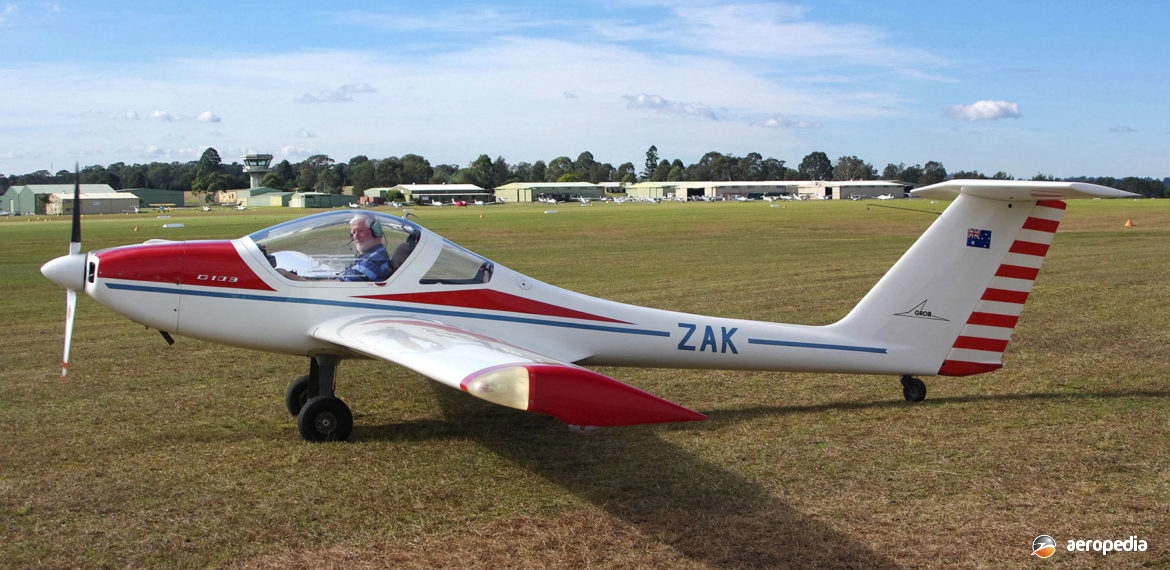Photograph:
Grob G-109 VH-ZAK (c/n 6085) at Camden, NSW in June 2009 (David C Eyre)
Country of origin:
Germany
Description:
Two-seat power glider
Power Plant:
One 60 kw (80 hp) Limbach SL2000EJ four-cylinder horizontally-opposed air-cooled engine
Specifications:
- Wingspan: 16.6 m (54 ft 5 in)
- strong>Length: 7.88 m (25 ft 10½ in)
- Height: 1.68 m (5 ft 6¾ in)
- Wing area: 20.4 m² (220 sq ft)
- Max speed: 244 km/h (152 mph)
- Cruising speed at 1,524 m (5,000 ft): 199 km/h (124 mph)
- Stalling speed: 76 km/h (47 mph)
- Rate of climb: 162 m/min (530 ft/min)
- Fuel capacity: 80 litres (17.6 Imp gals)
- Range at max cruise with 20 mins reserve: 898 km (558 miles)
- Take-off distance: 223 m (732 ft)
- Empty weight: 599 kg (1,320 lb)
- Useful load: 227 kg (500 lb)
- Loaded weight: 825 kg (1,822 lb)
History:
For some years now the Grob Flugzeugbau Company in Germany has built a series of high-performance gliders, including the G-103 Twin Astir. These aircraft have used the latest technology in glass and carbon fibre construction to give high efficiency and low maintenance in service. Because of the high utilisation of tug-aircraft, and winches, by gliding clubs over the years, private owners and gliding clubs have looked to a means whereby their aircraft could attain take-off and reach altitude under their own power, and this requirement has led to types such as the Fournier RF-4, Fournier RF-5, ICA Brasov IS-28M2, Stemme S-10 and Grob G-109. The glider fitted with its own engine allowed the spectrum of glider performance to be increased, being able to take-off from small or rough fields, climb to altitude, and have the ability to start and stop the engine as and when required.
The prototype G-109 first flew in 1980 with a 56 kw (75 hp) Limbach engine but was found to be somewhat underpowered; and its ability as a glider was a little below the level required. Grob then changed to the 2000 cc variant of the engine and extended the wingspan to 17.4 m (57 ft). Production commenced in mid 1983 at a rate of ten aircraft a month.
The Company developed the model G-109B with a 3500 cc engine, this appearing three years later, production being at a rate of 14 aircraft per month. In the late 1980s Grob discontinued production of the G-109B but the British Ministry of Defence ordered 60 examples in 1990 for the Royal Air Force (RAF) Elementary Flying Schools to replace the de Havilland DHC-1 Chipmunk. Burkhart Grob Flugzeugbau at Mindelheim placed the type back in production, the RAF aircraft becoming known as the Grob Vigilant T Mk I.
The first of the new series of powered sailplanes was produced by Grob Flugzeugbau, a Company initially devoted solely to the design and manufacture of a range of fibreglass sailplanes. The G-109 was entirely constructed of glass and carbon fibre composites, which proved themselves over the years in this type of design. The design was simple, not having flaps or retractable undercarriage, but was fitted with efficient dive brakes. The undercarriage was simple and designed to minimise drag. The wing profile was based on an Eppler section, but modified to eliminate undesirable ground effects for take-off and landing. The wing was described as unusually thick but, compared to normal glider sections, was an efficient laminar flow section.
One (D-KCOR) was flown by two German pilots, Michael Schultz and Wolfgang Muller, to Australia, leaving Hamburg on 10 November 1982 and arriving at Alice Springs, NT after flying some 18,523 km (11,510 miles) in early 1983.
The undercarriage was of the tail-wheel type, all wheels, including the tailwheel, being fully faired. Each main wheel was fitted with hydraulic disc brakes which could be used together or differentially as desired. The fuselage and canopy configuration were designed to provide additional lifting surfaces, and the wing was fully faired with tie-down points provided at each wingtip. The Limbach engine was originally derived from the Volkswagen engine, but in its two-litre form it has proven itself in its own right, and drives a three-position variable-pitch Hoffman designed V62 R/L160T propeller.
The first G-109 to be seen in Australia arrived during 1982, initially taking up residence with Alpine Soaring of Jindabyne, NSW. More than 80 Grob-built gliders have been imported to this region but only a few have been self-launched G-109s. Grob G-109s and G-109Bs registered have included VH-FFN (c/n 6049), VH-FFO (c/n 6091), VH-FFP (c/n 6071), VH-FFQ (c/n 6070), VH-FQY (c/n 6330), VH-FQZ (c/n 6329), VH-GUD (c/n 6069), VH-GUM (c/n 6222), VH-HDS (c/n 6147), VH-HNK (c/n 6262), VH-IIV (c/n 6128), VH-VKR (c/n 6061), VH-XQX (c/n 6065) and VH-ZAK (c/n 6085).
One VH-HNK (c/n 6262) registered to Flinders University of South Australia has seen some service as a small environmental research aircraft, operating on missions similar to those performed by the Diamond HK36TTC-ECO aircraft, being fitted with underwing pods to carry scientific research equipment. This was carried out in association with university programs.

